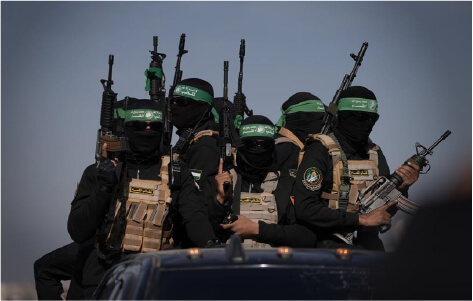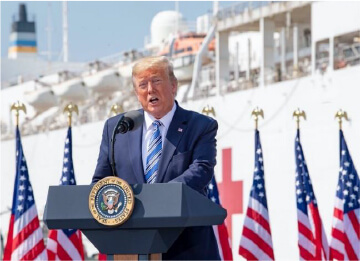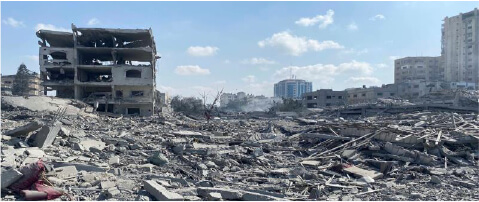



Militarily, Iran is in its most vulnerable position in decades. The country’s economy has been weakened by decades of extensive sanctions, economic mismanagement, corruption, and poor governance, and its forward defense strategy—relying on proxy forces such as Hezbollah, Hamas, and Shiite militias in Iraq, Syria, and Yemen—has been utterly decimated over the past year following the Hamas attack on Israel in October 2023.

Hamas continues to survive amidst the ruins of a completely devastated Gaza, but its ability to threaten Israel is currently negligible. The fall of Bashar Assad’s regime in Syria has disrupted arms supplies between Iran and Hezbollah, opening Syrian airspace for Israeli attacks on Iran. Unlike October 2023, when Hezbollah launched direct attacks on Israel immediately after the Gaza conflict began, this time the Lebanese militia has indicated it cannot afford another clash with Israel—and its support for Iran is unlikely to translate into direct military engagement against the Jewish state.
Critically significant was the massive extent of Israeli infiltration into Iran’s security services, revealing a systematic decay within the regime. Before the attack, Mossad launched a targeted disinformation campaign, using planted messages spread through Iranian channels to trigger an emergency meeting of nearly the entire senior leadership of Iran’s Revolutionary Guard air forces, including their commander, deputies, and key technicians. They gathered in a secret bunker near Tehran, which was hit by a precise airstrike, wiping out Iran’s top missile command. In a rigid and centralized command-and-control system, this made it impossible to launch over a thousand ballistic missiles aimed at Israeli territory—because no one with the authority to issue the order was left alive.
Immediately afterward, Israel launched an extensive sabotage campaign in Tehran and other strategic locations, targeting missile bases, infrastructure, and air defenses, which would arguably have taken years to prepare. According to some reports, Mossad sleeper cells infiltrated Iran as early as 2007 and smuggled hundreds of drones and military equipment into the country using commercial trucks. These assets remained dormant until activated hours before the operation.
Estimates suggest that over 15% of Iran’s ballistic missile arsenal was destroyed in the initial wave. Nearly all remaining critical air defense systems in and around Tehran were neutralized within the first hour. Iran’s ability to respond immediately collapsed, and what was meant to be a massive retaliatory strike was reduced to just 150–200 ballistic missiles launched 20 hours after the Israeli operation began. This is a fraction of what was expected, allowing Israel’s air defenses to intercept most of the missiles. In the meantime, Israel destroyed additional Iranian ballistic missiles and half of their launch systems, with Iran firing a total of about 500 missiles (which reportedly leaves them with less than half the arsenal meant to serve as a deterrent against the United States).
Iranian forward defense, in the form of Hamas and Hezbollah, was intended to deter attacks, while Iran’s conventional capabilities targeted Saudi Arabia, Kuwait, Bahrain, and U.S. bases in the region. Syria provided Iran with strategic depth on its western flank until the regime could acquire its own nuclear arsenal, but none of this holds true anymore as the proxy network lies in ruins, and the China-mediated détente with Saudi Arabia in 2023 means Iran is not in a position to retaliate against U.S. allies (and key Beijing partners) in the region. Moreover, the Iranian regime can hardly afford a massive economic escalation—an attack on Saudi oil exports for example would almost certainly cut off the regime’s last lifeline, oil exports to China, through U.S. or Israeli weapons. It could then be said that Tehran’s decades-long strategy, aimed at regional dominance, has catastrophically failed.

Three days after the campaign began, Israel disabled centrifuges at Iran’s largest enrichment facility in Natanz, killed up to ten top Iranian nuclear scientists and destroyed key parts of the supply chain for nuclear bomb production. This was far from sufficient to dismantle the Iranian nuclear program, however, which was the ultimate Israeli goal, and a failure of the military solution risks Iran abandoning its strategic pretense of banning nuclear weapons, expelling international inspectors, and accelerating its pursuit of an atomic bomb.
By the end of the campaign’s first week, the greatest challenge for Israel remained to eliminate Iran’s most fortified nuclear facility, Fordow, where Iran produces highly enriched uranium with no civilian use, just one step away from weapons-grade material. This facility carved deep into a mountainside near the Shi’a holy city of Qom, could only be destroyed—if at all—by the giant American GBU-57 (Massive Ordnance Penetrator) bombs.
Donald Trump decided to test this possibility on Saturday with Operation Midnight Hammer, which involved seven B-2 bombers undertaking an 18-hour flight to the target area, striking the underground nuclear facilities at Fordow and Natanz with MOP bombs. They then returned to Missouri without landing, while a U.S. Central Command submarine launched over two dozen Tomahawk cruise missiles at a third nuclear facility in Isfahan.

According to a press statement, no air defense missiles were fired at the attacking group during their approach or departure. The operation involved over 125 military aircraft, including a large number of tankers, strategic decoy flights, and direct support: ten F-22 Raptors, 12 F-35 Lightning IIs, and 12 F-16 Fighting Falcons, deployed to the region days earlier, along with F-15E Strike Eagles and additional F-16s already operating in the area. Six B-2 bombers likely struck Fordow, each with two MOP bombs, while one hit Isfahan; two others served as backups.
Preliminary damage assessments indicate that all three sites sustained significant damage with an extreme degree of destruction. While further details are needed, the facilities in Natanz and Isfahan are likely almost destroyed, and Fordow is probably at least out of commission—if not irreparably damaged.
Even if the Fordow facility is completely destroyed, however, Iran may have other covert pathways to produce a nuclear bomb, provided its stockpiles of enriched material remain intact. For years, Iran has denied the International Atomic Energy Agency access to camera footage from its centrifuge production facilities. Thus, somewhere in Iran (or even North Korea), there could be a large number of centrifuges. These could be installed in an as-yet-unknown underground facility, where a bomb could be developed and produced. Such a site need not be large—a few hundred advanced centrifuges could produce weapons-grade material from already enriched uranium in a very short time.
Here lies the biggest problem: according to American media, U.S. officials do not know the whereabouts of approximately 400 kg of highly enriched uranium, which may have been—possibly even likely—moved from Fordow to an unknown location. This is, of course, a narrative pushed by the Iranians, but unlike the relocation of most centrifuges and other sensitive equipment, it is not implausible. This material could technically be converted into weapons-grade material within weeks, though subsequent steps—such as turning the material into a tested, functional warhead and mounting it on a suitable delivery system, like a ballistic missile—are more complex. However, Iran has been working on all parts of this puzzle for decades.
If the enriched uranium stockpiles have indeed been moved, this poses a significant problem. Additionally, Israel will need to continue targeting other nuclear scientists and destroy testing, diagnostic, and production equipment that Tehran could use for immediate bomb production. To this end, Israel also attacked a nuclear archive, part of which it stole in 2018 when it removed thousands of documents about older Iranian nuclear projects, many of which were later publicized. However, despite its intelligence work and penetration of Iran’s system, Israel can never be certain it hasn’t missed something critical.

Iran launched several short- and medium-range ballistic missiles at Al Udeid Air Base in Qatar, which houses around 10,000 American troops as well as some members of the British Royal Air Force and Qatari military, in retaliation for U.S. strikes. Built in the mid-1990s, Al Udeid is the largest U.S. military installation in the Middle East and serves as the forward headquarters for U.S. Central Command. No casualties were reported from Monday’s strikes, with Qatar saying that it had “successfully” intercepted the missiles.
Tehran reportedly provided Qatari authorities with prior notice of the attack to reduce casualties. This coordination indicates that, while Iran felt compelled to symbolically retaliate against the United States—according to Iran’s Supreme National Security Council secretariat, the number of missiles fired at Al Udeid matched the number of bombs Washington used against Iran—it sought to provide all parties an opportunity to de-escalate and avoid further conflict.
A similar approach was employed in 2020 when Iran notified Iraq before launching ballistic missiles at U.S. forces stationed there in response to Washington’s assassination of Iranian commander Qassem Suleimani. Mere hours after the attack in an unexpected move, Donald Trump took to social media and announced a ceasefire between Israel and Iran, congratulating both countries on “having the Stamina, Courage, and Intelligence” to end the conflict.
Trump did not publicly clarify the start time of the cease-fire, leaving experts uncertain about its implementation details, especially given the time zone differences.
Shortly after the cease-fire reportedly began, Trump took to Truth Social to caution Israel against launching new strikes on Tehran. “ISRAEL. DO NOT DROP THOSE BOMBS. THAT’S A MAJOR VIOLATION. BRING YOUR PILOTS HOME, NOW!” he posted. Speaking to reporters, Trump expressed frustration with Israel, stating he was “not happy” and urged the country to “calm down.”
“You’ve got two countries fighting so long and so hard they don’t even know what the hell they’re doing,” Trump remarked, demonstrating rare criticism of a key U.S. ally.
Netanyahu’s office claims Iran fired several missiles at Israel after the cease-fire took effect, prompting the Israel Defense Forces (IDF) to conduct a limited strike on a radar system near Tehran. According to the office, Netanyahu agreed to avoid harsher strikes after a phone call with Trump. Iran denies breaching the cease-fire.
In the days after however, the fragile ceasefire under considerable pressure from the U.S. president held. Iran on one hand is too weak and does not appear to have any good options, while Israel would likely favor continuing the war, but cannot afford further affronts to its most important benefactor.
Donald Trump on Wednesday then said the United States will hold nuclear talks with Iranian officials next week, though Iran has not publicly acknowledged this. In the meantime, Iran’s Guardian Council approved a parliamentary bill on Thursday ordering the country to suspend cooperation with the IAEA “until the security of [Iran’s] nuclear facilities is ensured.”
As the status of Iran’s nuclear program slowly unfolds, Tehran is reportedly stepping up its internal security crackdown with arrests, executions, and military deployments. Officials told Reuters that Iran is focused on the threat of unrest, particularly in Kurdish areas.
As the battles progressed, pro-Iranian hacktivist groups intensified cyberattacks targeting Israel, its allies, and perceived neutral Arab states. We have covered the state-of-play of government-backed cyber-action in our previous update on the war which you can read here.

In the aftermath of escalating geopolitical tensions in the Middle East, a surge in politically motivated cyberattacks has been observed, driven primarily by pro-Iranian and pro-Palestinian hacktivist groups. These actors have focused their efforts on countries perceived as supportive of Israel, with campaigns targeting digital infrastructure across Israel, the UAE, Saudi Arabia, and other Gulf states. The attacks appear intended to signal dissent, apply pressure, and frame regional actors as complicit through their alleged neutrality or aid.
A growing number of threat groups are now engaged in this cyber conflict, expanding the scope of attacks beyond traditional targets. Campaigns have included disruptive operations against defense, government, and commercial sectors, accompanied by claims of data breaches and leaks. These activities reflect a broader strategy of undermining state credibility, compromising sensitive information, and exploiting regional divisions to amplify political narratives.
Despite a fragile ceasefire in the region, the cyber domain remains highly active. Institutions across government, academia, and the private sector continue to face targeting from ideologically motivated actors. These developments highlight the evolving nature of cyber-enabled influence operations, where digital disruption is increasingly used as a tool to provoke, destabilize, and gain visibility amid ongoing geopolitical unrest.

The regional balance of power has shifted dramatically. Iran’s influence has long relied on three pillars: its proxy network, ballistic missile arsenal, and nuclear program, but all three have been significantly compromised. The recent conflict has exposed Iran’s critical vulnerabilities, including its susceptibility to infiltration, and has dealt a major blow to its nuclear program. However, this is likely not the end of Iran’s nuclear ambitions or its pursuit of nuclear weapons. The United States may seek to engage GCC countries and European allies to resume negotiations for a new nuclear agreement, aiming to halt Iran’s uranium enrichment in exchange for limited sanctions relief. This could allow Iranian leaders to present a diplomatic victory to stabilize their regime.
Israel emerges from this conflict with its reputation as a formidable military power strengthened, having showcased its ability to project force and strike adversaries across the Middle East. The war has also underscored Jerusalem’s resolve to neutralize existential threats; however, many regional powers question the validity of Israel’s claims about the severity of these threats. Jerusalem appears unconcerned by such skepticism, driven largely by domestic political dynamics. Yet, Donald Trump’s clear reluctance to back further Israeli escalation imposes limits on the threat actor most willing to use force in this conflict.
Despite the reportedly successful U.S. strike on Fordow, uncertainty persists about whether Iran moved significant quantities of highly enriched uranium from the facility beforehand. If it did, Iran could utilize a few hundred advanced centrifuges and its stockpile of 60% enriched uranium at a small facility to produce weapons-grade material.
This underscores the need for a long-term diplomatic solution to address Iran’s nuclear ambitions. Without it, renewed U.S. or Israeli strikes may be necessary within months to prevent the very scenario that sparked this war: Iran acquiring nuclear weapons.
While the ceasefire halts open military conflict between Israel and Iran, it is likely to push their rivalry into the cyber domain. With physical strikes limited, both nations may intensify covert cyber operations to target critical infrastructure, nuclear programs, and proxy networks. This digital shadow war enables strategic disruption without direct confrontation, though it carries the risk of escalation if vital systems are compromised.